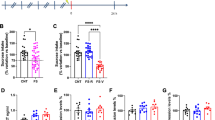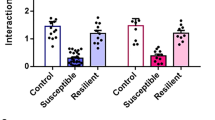Abstract
The adult brain is capable of adapting to internal and external stressors by undergoing structural plasticity, and failure to be resilient and preserve normal structure and function is likely to contribute to depression and anxiety disorders. Although the hippocampus has provided the gateway for understanding stress effects on the brain, less is known about the amygdala, a key brain area involved in the neural circuitry of fear and anxiety. Here, in mice more vulnerable to stressors, we demonstrate structural plasticity within the medial and basolateral regions of the amygdala in response to prolonged 21-day chronic restraint stress (CRS). Three days before the end of CRS, treatment with the putative, rapidly acting antidepressant, acetyl-l-carnitine (LAC) in the drinking water opposed the direction of these changes. Behaviorally, the LAC treatment during the last part of CRS enhanced resilience, opposing the effects of CRS, as shown by an increased social interaction and reduced passive behavior in a forced swim test. Furthermore, CRS mice treated with LAC show resilience of the CRS-induced structural remodeling of medial amygdala (MeA) stellate neurons. Within the basolateral amygdala (BLA), LAC did not reduce, but slightly enhanced, the CRS-increased length and number of intersections of pyramidal neurons. No structural changes were observed in MeA bipolar neurons, BLA stellate neurons or in lateral amygdala stellate neurons. Our findings identify MeA stellate neurons as an important component in the responses to stress and LAC action and show that LAC can promote structural plasticity of the MeA. This may be useful as a model for increasing resilience to stressors in at-risk populations.
This is a preview of subscription content, access via your institution
Access options
Subscribe to this journal
Receive 12 print issues and online access
$259.00 per year
only $21.58 per issue
Buy this article
- Purchase on Springer Link
- Instant access to full article PDF
Prices may be subject to local taxes which are calculated during checkout





Similar content being viewed by others
References
McEwen BS . Physiology and neurobiology of stress and adaptation: central role of the brain. Physiol Rev 2007; 87: 873–904.
McEwen BS . Stress, sex, and neural adaptation to a changing environment: mechanisms of neuronal remodeling. Ann NY Acad Sci 2010; 1204: 38–59.
McEwen BS, Gray JD, Nasca C . Recognizing resilience: learning from the effects of stress on the brain. Neurobiol Stress 2015; 1: 1–11.
Southwick SM, Charney DS . The science of resilience: implications for the prevention and treatment of depression. Science 2012; 338: 79–82.
McEwen BS . Stress and hippocampal plasticity. Ann Rev Neurosci 1999; 22: 105–122.
Radley JJ, Sisti HM, Hao J, Rocher AB, McCall T, Hof PR et al. Chronic behavioral stress induces apical dendritic reorganization in pyramidal neurons of the medial prefrontal cortex. Neuroscience 2004; 125: 1–6.
Sheline YI, Wang PW, Gado MH, Csernansky JG, Vannier MW . Hippocampal atrophy in recurrent major depression. Proc Natl Acad Sci USA 1996; 93: 3908–3913.
McEwen BS, Nasca C, Gray JD . Stress effects on neuronal structure: hippocampus, amygdala, and prefrontal cortex. Neuropsychopharmacology 2015; 41: 3–23.
Vyas A, Mitra R, Shankaranarayana Rao BS, Chattarji S . Chronic stress induces contrasting patterns of dendritic remodeling in hippocampal and amygdaloid neurons. J Neurosci 2002; 22: 6810–6818.
Phillips RG, LeDoux JE . Differential contribution of amygdala and hippocampus to cued and contextual fear conditioning. Behav Neurosci 1992; 106: 274–85.
Vinkers CH, Bijlsma EY, Houtepen LC, Westphal KG, Veening JG, Groenink L et al. Medial amygdala lesions differentially influence stress responsivity and sensorimotor gating in rats. Physiol Behav 2010; 99: 395–401.
Wang Y, Zhao S, Wu Z, Feng Y, Zhao C, Zhang C . Oxytocin in the regulation of social behaviours in medial amygdala-lesioned mice via the inhibition of the extracellular signal-regulated kinase signalling pathway. Clin Exp Pharmacol Physiol 2015; 42: 465–474.
Pitkanen A, Savander V, LeDoux JE . Organization of intra-amygdaloid circuitries in the rat: an emerging framework for understanding functions of the amygdala. Trends Neurosci 1997; 20: 517–523.
Vyas A, Jadhav S, Chattarji S . Prolonged behavioral stress enhances synaptic connectivity in the basolateral amygdala. Neuroscience 2006; 143: 387–393.
Mitra R, Jadhav S, McEwen BS, Vyas A, Chattarji S . Stress duration modulates the spatiotemporal patterns of spine formation in the basolateral amygdala. Proc Natl Acad Sci USA 2005; 102: 9371–9376.
Bennur S, Shankaranarayana Rao BS, Pawlak R, Strickland S, McEwen BS, Chattarji S . Stress-induced spine loss in the medial amygdala is mediated by tissue-plasminogen activator. Neuroscience 2007; 144: 8–16.
Felix-Ortiz AC, Tye KM . Amygdala inputs to the ventral hippocampus bidirectionally modulate social behavior. J Neurosci 2014; 34: 586–595.
Tejeda HA, O'Donnell P . Amygdala inputs to the prefrontal cortex elicit heterosynaptic suppression of hippocampal inputs. J Neurosci 2014; 34: 14365–14374.
Nasca C, Xenos D, Barone Y, Caruso A, Scaccianoce S, Matrisciano F et al. l-acetylcarnitine causes rapid antidepressant effects through the epigenetic induction of mGlu2 receptors. Proc Natl Acad Sci USA 2013; 110: 4804–4809.
Russo SJ, Charney DS . Next generation antidepressants. Proc Natl Acad Sci USA 2013; 110: 4441–4442.
Flight MH . Antidepressant epigenetic action. Nat Rev Neurosci 2013; 14: 226.
Nasca C, Bigio B, Zelli D, Nicoletti F, McEwen BS . Mind the gap: glucocorticoids modulate hippocampal glutamate tone underlying individual differences in stress susceptibility. Mol Psychiatry 2015; 20: 755–763.
McEwen BS, Nasca C, Hodes GE, Kana V, Nestler EJ, Russo SJ . Glucocorticoids-IL6 crosstalk allows identification of inherent individual differences that predict and promote vulnerability to social stress. SfN Abstract 2015.
Nasca C, Orlando R, Marchiafava M, Boldrini P, Battaglia G, Scaccianoce S et al. Exposure to predator odor and resulting anxiety enhances the expression of the alpha2 delta subunit of voltage-sensitive calcium channels in the amygdala. J Neurochem 2013; 125: 649–656.
Hodes GE, Pfau ML, Leboeuf M, Golden SA, Christoffel DJ, Bregman D et al. Individual differences in the peripheral immune system promote resilience versus susceptibility to social stress. Proc Natl Acad Sci USA 2014; 111: 16136–16141.
Lein ES, Hawrylycz MJ, Ao N, Ayres M, Bensinger A, Bernard A et al. Genome-wide atlas of gene expression in the adult mouse brain. Nature 445: 168–176.
Magarinos AM, McEwen BS . Stress-induced atrophy of apical dendrites of hippocampal CA3c neurons: involvement of glucocorticoid secretion and excitatory amino acid receptors. Neuroscience 1995; 69: 89–98.
Goldwater DS, Pavlides C, Hunter RG, Bloss EB, Hof PR, McEwen BS et al. Structural and functional alterations to rat medial prefrontal cortex following chronic restraint stress and recovery. Neuroscience 2009; 164: 798–808.
Sah P, Faber ES, Loped De Armentia M, Power J . The amygdaloid complex: anatomy and physiology. Physiol Rev 2003; 83: 803–834.
Nasca C, Zelli D, Bigio B, Piccinin S, Scaccianoce S, Nisticò R et al. Stress dynamically regulates behavior and glutamatergic gene expression in hippocampus by opening a window of epigenetic plasticity. Proc Natl Acad Sci USA 2015; 112: 14960–14965.
Kishi T, Tsumori T, Yokota S, Yasui Y . Topographical projection from the hippocampal formation to the amygdala: a combined anterograde and retrograde tracing study in the rat. J Comp Neurol 2006; 496: 349–368.
O'Leary OF, Cryan JF . A ventral view on antidepressant action: roles for adult hippocampal neurogenesis along the dorsoventral axis. Trends Pharmacol Sci 2014; 35: 675–687.
Pettegrew JW, Levine J, McClure RJ . Acetyl-l-carnitine physical–chemical, metabolic, and therapeutic properties: relevance for its mode of action in Alzheimer's disease and geriatric depression. Mol Psychiatry 2000; 5: 616–632.
Wang W, Lu Y, Xue Z, Li C, Wang C, Zhao X et al. Rapid-acting antidepressant-like effects of acetyl-l-carnitine mediated by PI3K/AKT/BDNF/VGF signaling pathway in mice. Neuroscience 2015; 285: 281–291.
Schaevitz LR, Nicolai R, Lopez CM, D'Iddio S, Iannoni E, Berger-Sweeney JE . Acetyl-l-carnitine improves behavior and dendritic morphology in a mouse model of Rett syndrome. PLoS ONE 2012; 7: e51586.
Fritz IB, McEwen BS . Effects of carnitine on fatty-acid oxidation by muscle. Science 1959; 129: 334–335.
Nasca C, Zelli D, Lau T, McEwen BS . mGlu2 is a key mediator in the responses to next-generation antidepressant treatments: epigenetic mechanisms of neuronal plasticity. SfN Abstract 2014; 2014.
McEwen BS . Stress-induced remodeling of hippocampal CA3 pyramidal neurons. Brain Res 2015; pii: S0006-8993(15)00982-8.
Magariños AM, McEwen BS, Saboureau M, Pevet P . Rapid and reversible changes in intrahippocampal connectivity during the course of hibernation in European hamsters. Proc Natl Acad Sci USA 2006; 103: 18775–18780.
Arendt T, Stieler J, Strijkstra AM, Hut RA, Rudiger J, Van der Zee EA et al. Reversible paired helical filament-like phosphorylation of tau is an adaptive process associated with neuronal plasticity in hibernating animals. J Neurosci 2003; 23: 6972–6981.
Steger MF, Kashdan TB . Depression and everyday social activity, belonging, and well-being. J Counsel Psychol 2009; 56: 289–300.
Bickart KC, Wright CI, Dautoff RJ, Dickerson BC, Barrett LF . Amygdala volume and social network size in humans. Nat Neurosci 2011; 14: 163–164.
Krishnan V, Han MH, Graham DL, Berton O, Renthal W, Russo SJ et al. Molecular adaptations underlying susceptibility and resistance to social defeat in brain reward regions. Cell 2007; 131: 391–404.
Swanson LW, Petrovich GD . What is the amygdala? Trends Neurosci 1998; 8: 323–331.
Mouly AM, Sullivan R . Memory and plasticity in the olfactory system: from infancy to adulthood. In: Menini A (ed). The Neurobiology of Olfaction, Chap 15. CRC Press: Boca Raton, FL, USA, 2010.
Li CI, Maglinao TL, Takahashi LK . Medial amygdala modulation of predator odor-induced unconditioned fear in the rat. Behav Neurosci 2004; 118: 324–332.
Acknowledgements
We thank Anjali Ferris for her commitment in blind analyses for structural and behavioral experiments. This work was supported by the AFSP (American Foundation for Suicide Prevention), HDRF (Hope for Depression Research Foundation), NIH Grant RO1 MH41256 and by Grant UL1 TR000043 from the National Center for Advancing Translational Sciences (NCATS), National Institutes of Health (NIH) Clinical and Translational Science Award (CTSA) program.
Author information
Authors and Affiliations
Corresponding authors
Ethics declarations
Competing interests
The authors declare no conflict of interest.
Additional information
Supplementary Information accompanies the paper on the Molecular Psychiatry website
Rights and permissions
About this article
Cite this article
Lau, T., Bigio, B., Zelli, D. et al. Stress-induced structural plasticity of medial amygdala stellate neurons and rapid prevention by a candidate antidepressant. Mol Psychiatry 22, 227–234 (2017). https://doi.org/10.1038/mp.2016.68
Received:
Revised:
Accepted:
Published:
Issue Date:
DOI: https://doi.org/10.1038/mp.2016.68
This article is cited by
-
Acute gut inflammation reduces neural activity and spine maturity in hippocampus but not basolateral amygdala
Scientific Reports (2022)
-
Insulin receptor substrate in brain-enriched exosomes in subjects with major depression: on the path of creation of biosignatures of central insulin resistance
Molecular Psychiatry (2021)
-
Dendritic spine density is increased on nucleus accumbens D2 neurons after chronic social defeat
Scientific Reports (2020)
-
The association of PTSD symptom severity with amygdala nuclei volumes in traumatized youths
Translational Psychiatry (2020)
-
Adolescent social instability stress alters markers of synaptic plasticity and dendritic structure in the medial amygdala and lateral septum in male rats
Brain Structure and Function (2019)



